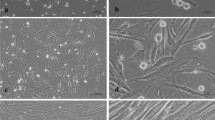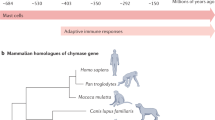Abstract
A PURE population of mast cells develops when suspensions of lymphoid cells prepared from mice pre-immunised with horse serum are grown on embryonic mouse skin fibroblast monolayers1. These in vitro matured mast cells are capable of undergoing repeated cycles of degranulation and regeneration2. Both IgG1 antibody and the corresponding antigen and the compound 48/80 (ref. 3) trigger degranulation of more than 90% of the mast cells, releasing 80 to 90% of their histamine content2. This produces an immediate effect on the cells in the fibroblast monolayer. The well-stretched cytoplasm is displaced, opening numerous ‘windows’ scattered over the whole monolayer2. These capacities of cultured mast cells raise questions on the relationships between them, the degranulating agent and the degranulating products released into the medium. Using our tissue culture, mast cell behaviour can be studied in the continuous presence of the degranulating agent or of the degranulating products. We show here that mast cells regenerate degranulation irrespective of the continuous presence of the histamine releaser compound 48/80, but they become unresponsive to its degranulating effect, although they are totally degranulated by IgG1 and the corresponding antigen.
This is a preview of subscription content, access via your institution
Access options
Subscribe to this journal
Receive 51 print issues and online access
$199.00 per year
only $3.90 per issue
Buy this article
- Purchase on Springer Link
- Instant access to full article PDF
Prices may be subject to local taxes which are calculated during checkout
Similar content being viewed by others
References
Ginsburg, H. & Lagunoff, D. J. Cell Biol. 35, 685–697 (1967).
Ginsburg, H., Nir, Y., Hammel, I., Eren, R., Weissman, B. A. & Naot, Y. Immunology 485–502 (1978).
Paton, W. D. M. Br. J. Pharmac. 6, 499–508 (1951).
Ginsburg, H., Hollander, N. & Feldman, M. J. exp. Med. 134, 1062–1082 (1971).
Lagunoff, D., Chi, E. Y. & Wan, H. Biochem. Pharmac. 24, 1573–1578 (1975).
Marshall, P. W., Thomson, D. S. & Evans, D. P. Int. Archs Allergy Appl. Immun. 51, 274–383 (1976).
Moore, A. & Khairallah, P. A. J. Pharm. exp. Therap. 197, 575–581 (1976).
Spiegelberg, H. L. Adv. Immun. 19, 259–289 (1974).
Author information
Authors and Affiliations
Rights and permissions
About this article
Cite this article
GINSBURG, H., BEN-SHAHAR, D., HAMMEL, I. et al. Degranulation capacity of cultured mast cells in the presence of histamine releaser. Nature 280, 151–153 (1979). https://doi.org/10.1038/280151a0
Received:
Accepted:
Published:
Issue Date:
DOI: https://doi.org/10.1038/280151a0
This article is cited by
-
Electron microscopical study of rat mast cell maturation
Virchows Archiv B Cell Pathology Including Molecular Pathology (1983)
-
Electron microscopic study of the regeneration in vivo of rat peritoneal mast cells after histamine secretion
Cell and Tissue Research (1982)
Comments
By submitting a comment you agree to abide by our Terms and Community Guidelines. If you find something abusive or that does not comply with our terms or guidelines please flag it as inappropriate.



